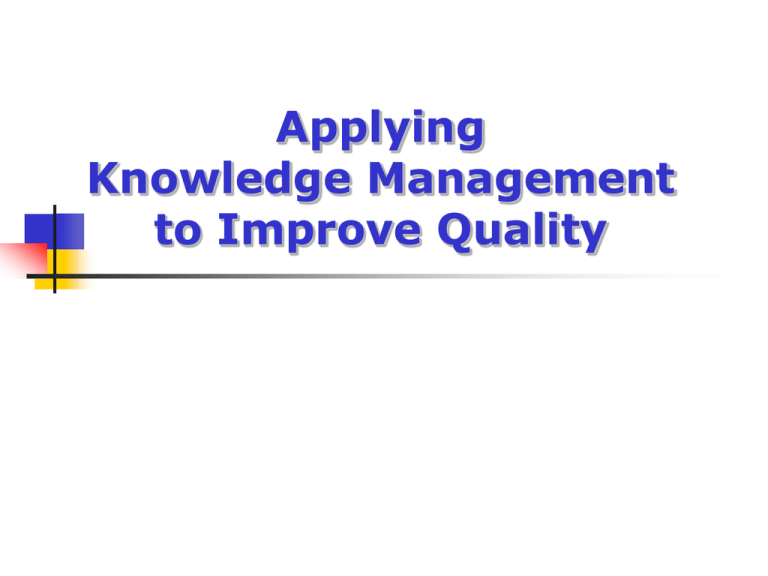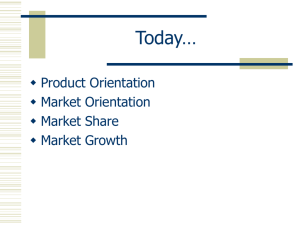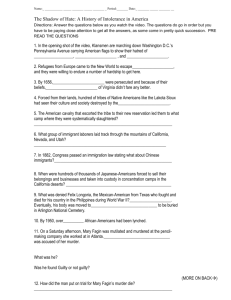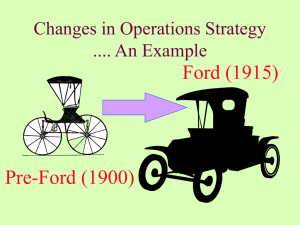Applying Knowledge Management to Improve Quality
advertisement

Applying Knowledge Management to Improve Quality High Priority given to Quality at Ford Motor Company Strategy: Quality is JOB #1 Quality Operating System (QOS) Performance to Standards Quality Leadership Initiative (QLI) Engage all employees Consumer Driven 6-Sigma Data driven decision making 2 Leverage Quality Improvement Programs Corporate Strategy: Quality is JOB 1 Top Down: Corporate Programs QOS, QLI, 6-Sigma… Bottom Up: Employee based proven methods to improve quality… …apply Knowledge Management 3 Applying KM to Improve Quality Illustrative examples will be displayed and discussed during the presentation 4 Measurable Quality Improvements at Ford Motor Company JD Power Initial Quality Study: Ford Motor Company products had more than 16% improvement 2002-2003 Consumer Reports 2004 – New Car Preview – 19 Ford Motor Company products received “Recommended Buys” Warranty Spending is down 18% from 2002 Consumer Driven 6-Sigma efforts saved more than $1.3 B since its inception in 2000 Source: FCN December 15th, 2004, & 2003 Annual Report 5 Ranked #4 by Fortune 500 Manufacture and distribute automobiles in 200 markets across 6 Continents 2003 Global Revenues: $164 Billion 327,000 Employees 2003 - Celebrated 100th Anniversary 6 Very Brief History of Best Practice Replication 1994: Formalized process of replicating proven practices 1996: Launched Ford Web Hub; BPR used the Web across 53 plants globally. 1995 – Faxing best practices amongst vehicle assembly plants As of 2004: Launched 53 communities of practice. 2,334 Focal Points: Vehicle Assembly, Plant HR, Paint Engineering, Ergonomics, Safety, Plant IT, Finance, Environmental… 7 BPR Principles Capture only Proven, High Value Practices Manage the Process Value-Add to business must be identified Business Partners provide the content and the people, IT group provides the enabling tool 8 Selection and Replication of Proven Practices at Ford Many Sources of Ideas Task Lessons Learned Site Visits 6-Sigma CPIPS 8Ds Practice Implemented at a Ford Facility FPS Inspiration Practice is Proven AND generates Value Best Practice Replication with prescribed Roles & Responsibilities Collect Approve & Distribute Review by each Location Adopt/ Don’t Adopt Decision Management Review of Results 9 Typical BPR Community of Practice Senior Leadership Community Gatekeeper Site 1 Focal Point Knowledge Workers Site 2 Site 3 Focal Point Focal Point Knowledge Workers Knowledge Workers etc. Focal Point Knowledge Workers 10 Best Practice Replication 9 Step Process 1 DRAFT PRACTICE: Focal Point at Locations enter Proven Practices: 4 PUSH the KNOWLEDGE: Outlook email notification to all Community Focal Points at each Location. 7 FEEDBACK: Focal Point at each location enters adopt/not adopt decision. 2 REVIEW DRAFT PRACTICES: Gatekeeper looks for replicable practices; Collaborates with SMEs. 5 PRACTICES REVIEWED by each location team members for applicability. 8 REPORTS: Progress Reports available to all 3 APPROVE PRACTICE: Gatekeeper approves only replicable high-value practices. 6 ADAPT/ ADOPT/ NOT ADOPT DECISION made at each location. “Copy with Pride” 9 PEER RECOGNITION of practice originators & replicators. 11 BPR Results Summary Since 1996: Average of 10,000+ replications/yr 2,800+ active high value practices. 53 Communities of Practice 2,334 active Focal Points Process licensed to Shell Oil, Nabisco, Kraft Foods, and US Navy 12 Contacts Stan Kwiecien skwiecie@ford.com Best Practice Replication Deployment Manager Sanjay Swarup sswarup@ford.com Senior Knowledge Management Specialist Robyn Valade rvalade@ford.com Best Practice Integration Manager Dar Wolford dwolford@ford.com Manager, Venture Transitions and Knowledge Management 13 Applying KM to Improve Quality # 1 KM System must capture Knowledge AND value metrics (Cost Savings, Quality, etc.) 14 Applying KM to Improve Quality # 1 BPR has 168 different types of value metrics in 6 broad categories Safety Delivery Quality Cost Motivation Environment 15 Applying KM to Improve Quality # 1 Illustrative examples will be displayed and discussed during the presentation 16 Applying KM to Improve Quality # 2 KM System must capture Quality Improvement Practices from ALL areas of the Enterprise. 17 Applying KM to Improve Quality # 2 Illustrative examples will be displayed and discussed during the presentation 18 Applying KM to Improve Quality # 2 All 53 Communities of Practice share quality improvement practices: Examples Paint Engineering Final Assembly Stamping Operations Environmental Ford Financial Industrial Materials Human Resources Lean Manufacturing (Ford Production System) Energy 19 Applying KM to Improve Quality # 3 Capture the replication and feedback of Improved Quality Practices 20 Applying KM to Improve Quality # 3 Illustrative examples will be displayed and discussed during the presentation 21 Applying KM to Improve Quality # 4 Establish a Robust process to transfer replicable findings of closed 6-Sigma projects to the KM System 22 Applying KM to Improve Quality # 4 Illustrative examples will be displayed and discussed during the presentation 23 Applying KM to Improve Quality # 5 Leadership MUST provide ongoing encouragement and support for initiating AND replicating Quality Improvement Practices 24 Applying KM to Improve Quality # 5 Sample of Recognition given to Initiators 25 Why use KM to Leverage Quality Efforts? Quality Improvement without KM Quality Improvement with KM Quality Local only Enterprise-wide Value Value generated is local only Maximize Value Enterprise-wide Max effort at one location Minimal additional effort for Enterprisewide replication Effort 26 High KM activity AND High Quality Improvement activity = Maximum Value High Quality Improvement Activity Medium Value Maximum Value Minimum Value Medium Value Low Low KM activity High 27 Recap: Applying KM to Improve Quality 1: Capture Knowledge AND Value Metrics #2: Enable enterprise wide capture of Quality improvements #3: Replicate and capture feedback #4: Robust Process of linking KM and 6-Sigma #5: Leadership MUST provide ongoing encouragement and support 28







